 Image search results - "port" Image search results - "port" |

Monorail to Chiba Koen Station 千葉公園駅
|
|

Women at the starting line for triathlon
|
|
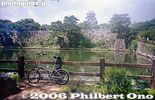
My bicycle
|
|

Carrying back a single sculling boat
|
|
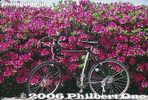
My bicycle somewhere in Gamagori.
|
|
|
|

Chiba Station and monorail
|
|

Boat for Taketomi at Ishigaki Port.
|
|

Inside monorail
|
|

June 9, 2007. Hula dancers rush to Pukari Sanbashi Pier where the Hokule'a canoe is to dock. ぷかりさん橋
|
|

A crowd of a few hundred on hand to greet Hokule'a's arrival.
|
|

JR Chiba Station
|
|

People crowd the waterfront near Pukari Sanbashi Pier.
|
|

Museum's observation deck.
|
|

People crowd the waterfront near Pukari Sanbashi Pier.
|
|
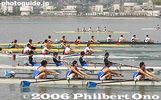
Close-up of rowers at Asahi Regatta
|
|

Hokule'a already in sight well before 11 am when it was scheduled to dock.
|
|

Hokule'a and escort ship Kama Hele. What makes this canoe so special and famous is that it was used to sail from Hawaii to Tahiti (and many other places) without any modern navigational instruments.
|
|
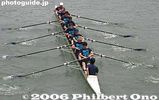
Kyoto Univ. alumni
|
|

They only referred to the sun, moon, the stars, and ocean waves to navigate through the vast Pacific Ocean or Polynesia. This is called celestial navigation. Extremely few people can do this, and the Hawaiians are learning this skill of long-ago.
|
|

Heavyweight judo Olympic gold medalist Satoshi Ishii (石井 慧) was also at Yasukuni Shrine on Aug. 15, 2009. He was very kind and signed autographs, shook hands, and took photos with a lot of people.
|
|

They wanted to prove that the original native Hawaiians were able to sail between Tahiti to Hawaii on purpose, and that they did not land on Hawaii by accident.
|
|

Hokule'a and Yokohama Bay Bridge in the background.
|
|

One sail unraveled.
|
|

Nearing Pukari Sanbashi Pier. The question was, which side of the pier would it dock? (Was going the other side so I rushed over to the other side.)
|
|

This is early in the morning when the 54 portable shrines who had gathered in front of the shrine depart for the procession one after another.
|
|

Cycling for triathlon
|
|

Hokule'a nears the dock.
|
|

In front of Tomioka Hachimangu Shrine on Eitai-dori road.
|
|

A rope is thrown to the dock from Hokule'a.
|
|
|

Niiya Hitomi, the first woman runner I saw went on to win the women's division. I wondered where the women runners were. They were more than 20 min. behind the men to finish. 新谷仁美 東京マラソン
|
|
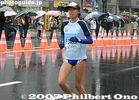
Niiya Hitomi, leading woman runner and later fastest woman to finish with a time of 2 hr. 31 min. 1 sec. Age 18. 新谷仁美 東京マラソン
|
|

Hokule'a arrives right on schedule at 11 am on June 9, 2007. Yokohama is its last stop.
|
|
|

Hula dancers
|
|

As the mikoshi depart, there is some entertainment at the Tomioka Hachimangu Shrine.
|
|

Conch shell blowers signal the canoe's arrival.
|
|

Taiko drummers at Tomioka Hachimangu Shrine.
|
|
|
|
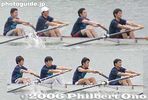
Kyodai alumni in their 20s and 30s
|
|

Pulling Hawaii's most famous canoe to dock.
|
|

In front of the shrine, a shrine priest blesses each portable shrine as it departs to join the procession.
|
|

Shiga University women rowers
|
|

Under overcast skies, Hokule'a docks.
|
|

The portable shrines are paraded through a route which will take them almost all day to complete, from 7:30 am to 3 pm.
|
|
|

The mikoshi are splashed with water in whichever way possible. This is in the middle of summer, so it's a good way to cool off.
|
|

Escort ship (powered by a Yanmar engine) Kama Hele also docks soon afterward.
|
|

Each mikoshi is preceded by a row of women carrying lanterns and wands. Also see the video at YouTube
|
|

Koinobori carp streamers adorn Hokule'a. A great Japanese touch.
|
|

People in happi coats carry the mikoshi while shouting "Wasshoi, wasshoi!"
|
|
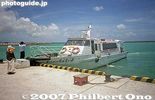
Taketomi Port boat for Ishigaki
|
|
|
|

Standard uniform of portable shrine bearers (for both men and women).The headband may be tied at the front or back of the head. It may also be tied on the head like a bonnet. There is a variety of ways of tying the headband.
The happi coat bears the name of the parish or district the person belongs to. The same name is displayed on the respective portable shrine. The shorts are white and skintight. Worn by both men and women. Also called Han-momo or Han-momohiki. The white tabi (sock-like shoe) has a rubber sole.
|
|

Escort ship Kama Hele flying the Japanese, Hawaiian, and Yanmar flags at Yokohama.
|
|

Welcome banner from Yanmar
|
|
|

Portable shrines
|
|

Crowd on the waterfront near the pier.
|
|
|

Hokule'a crew members
|
|

"Hey Ho, Let's Go!"
|
|

The Royal Order of Kamehameha I take part in arrival ceremonies. 入港式
|
|
|

Running in triathlon
|
|

Hokule'a arrival ceremonies
|
|
|

This mikoshi is being carried by all women, already soaked to the bone. They carry the mikoshi flat on their shoulders. This is called "Hira katsugi," literally "flat carrying."There are four basic methods of carrying a portable shrine. This is the most basic method where they carry it flat on their shoulders. This is called "Hira katsugi," literally "flat carrying."
|
|
|

Captain Bruce Blankenfeld places a lei on the bow.
|
|
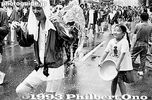
Splash you. This is a day when kids can be mean to grown-ups. This little girl kept filling up her bowl and ran around splashing some unlucky person.I hope that's her school teacher.
|
|

Akiko Sekine who later won the women's triathlon.After cycling, they ran for 10 km. About 30 min. later, this woman, Akiko Sekine won the triathlon. She was one of athletes who went to the Athens Olympics (placing 12th).
|
|

Hula dancers
|
|

Kyoto University's winning rowing crew
|
|

Hula dancers take part in arrival ceremonies.
|
|

Water splashing truck near Kiyosu-bashi Bridge
|
|
|

Water hose at Kiyosu-bashi Bridge
|
|

Hokule'a crew dance on the canoe.
|
|

Crossing Kiyosu-bashi Bridge over Sumida River.
|
|

Royal Order of Kamehameha I
|
|

Crossing Kiyosu-bashi Bridge
|
|

Nagano Winter Olympics women's ice hockey match.
|
|

Royal Order of Kamehameha I wear red and gold capes.
|
|

Crossing Kiyosu-bashi Bridge
|
|

Royal Order of Kamehameha I leave the pier.
|
|

Raising the mikoshi on Kiyosu-bashi Bridge
|
|

Crossing Kiyosu-bashi Bridge. They chant "wasshoi wasshoi!" as they carry the mikoshi. 清洲橋
|
|
|
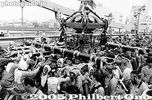
Crossing Kiyosu-bashi Bridge
|
|

Conch shell blower
|
|

Crew members hug each other.
|
|
|

Former Yokozuna Akebono (blue shirt) and his family were also on the pier. (Wife and daughter in orange.)
|
|

With raised arms, this is one way to carry the mikoshi.
|
|

Nainoa Thompson and other crew members get off the boat. Nainoa was on board, but was not part of the crew who brought the canoe to Yokohama.
|
|

A horde of people follow each portable shrine.
|
|

Japan's goalie takes a break at Nagano Winter Olympics women's ice hockey match.Her helmet is dotted with Print Club photo stickers.
|
|
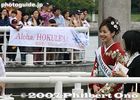
Miss Yokohama also took part in the arrival ceremonies.
|
|
|

綿打池
|
|

The portable shrine (mikoshi) passes through Hie Shrine's torii to join the procession. 神輿
|
|

Nagano Winter Olympics women's ice hockey match.
|
|

Control tower equipment.
|
|

Arrival ceremony ends and people start to leave the pier.
|
|

Future Hokule'a Captain, Ka'iu Murphy.
|
|
|

All the crew members met applause and handshakes.
|
|

Phoenix atop a portable shrine.
|
|

All the crew members were very friendly to all. This is Captain/Navigator Chadd Paishon.
|
|

Kiyosu-bashi Bridge over the Sumida River, Important Cultural Property 清洲橋 国の重要文化財
|
|
|

Crossing over Eitai-bashi Bridge. 永代橋
|
|

Mikoshi
|
|

Kimo
|
|

Captain Blankenfeld who piloted the canoe to Yokohama.
|
|

Finally, Nainoa Thompson makes his way from the pier and into the crowd.
|
|

Nainoa Thompson
|
|
|

Nainoa shook every single hand.
|
|
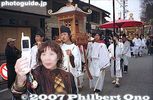
A middle-aged woman uses her camera phone to photograph herself. "I was here!"
|
|

He shook hands with EVERYBODY and ANYBODY.
|
|
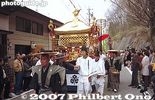
Portable shrine 神輿
|
|
|

Portable shrine 神輿
|
|

The crowd was thrilled to be so close to this man full of aloha.
|
|

Tokyo Big Sight in sight
|
|

People line up to shake Nainoa's hand or get his autograph or take his picture.
|
|
|

Right turn here
|
|

Nainoa has a habit of crouching on his knees so he can use his knee as a backing to sign autographs.
|
|

"Here you go!"
|
|

Plus a handshake for this little guy...
|
|

He never refused to sign an autograph.
|
|

A portable shrine crosses Eitai-bashi Bridge.
|
|

A portable shrine crosses Eitai-bashi Bridge.
|
|

A mikoshi arrives at Hie Shrine.
|
|
|
|

Another portable shrine crosses Eitai-bashi Bridge.
|
|

They pass through the ring.
|
|

He never refused to shake a hand.
|
|

Current time: 5 hr. 8 min. 15 sec.
|
|

Using a water hose is an efficient way to get people wet. But see what the big boys use..
|
|

In front of the shrine, the priest blesses the mikoshi portable shrine.
|
|

This woman put a small necklace on him.
|
|

Endless stream of runners heads for the finish.
|
|

A fire hose. The local fire department with a fire hose on Eitai-dori avenue.
|
|

The portable shrines came one after another.
|
|

I have never seen anyone who shook everybody's hand, signed autographs for everyone, and posed for all photographers. ナイノア・トンプソン
|
|

The water hose is now handled by volunteers, not real firemen.
|
|
|

Finally at the end, a little girl's artwork on a sheet of cloth catches his eye.
|
|
|

He poses with the girl.
|
|

Every time, the water hoses are at the same location.
|
|
|

He was so touched and impressed that he gave her a hug.
|
|

Water spray
|
|

Finish line dead ahead
|
|
|

He actually wanted her to keep her magnificant work of art, but she wanted him to have it.
|
|
|
|

The little girl was in awe and speechless.
|
|

Portable shrine 御羽車
|
|
|

He accepts the little girl's impressive gift.
|
|
|
|

He folds the sheet neatly and carries it with him to a press conference which he was late in attending. An ideal Goodwill Ambassador.
|
|

Crowd on Eitai-dori road
|
|
|
|

The marathon course was 42.19 km long.
|
|

After crossing Eitai-bashi Bridge, the portable shrines headed for the main stretch on Eitai-dori avenue already filled with people. The wettest and most crowded part of the festival is held along this one kilometer of road between the bridge and shrine.
|
|

Quite a spectacle.
|
|

June 10, 2007. A formal welcoming ceremony was held the next day on an outdoor terrace near the pier. Unfortunately, it was a rainy day and attendance was much smaller than the day before. 入港歓迎セレモニー
|
|
|
|
|

Captain Blankenfeld receives a gift.
|
|
|
|

Hie Shrine Sanno Matsuri
|
|

The ceremony included hula chanting and dancing.
|
|

This is the final stretch and wettest part of the festival.
|
|
|

Hi mom!
|
|

Prepared for the water...
|
|
|
|
|
|
|

A large truck filled with water with people using buckets to splash water in rapid succession.
|
|

A local taiko troupe give a spectacular performance. 学校法人国際学園 星槎国際高等学校
|
|

View from behind the "water truck." This goes on for about 15 seconds. The truck is refilled with a fire hose. All in the name of purification.
|
|

Portable shrine housing the spirit of Sugawara Michizane. This is the most important thing in the procession. 御鳳輦
|
|
|

During a break, two kids get water.
|
|
|
|
|
|

In return, the crew performs the haka dance.
|
|
|
|

A huge number of taiko drummers perform near the finish line. This taiko group is called Kodaijin. 鼓代神 Web site at www.geocities.jp/kodaijin_kdj/
|
|

A small crowd watch the welcome ceremony. パシフィコ横浜国立大ホール前テラス
|
|

Fukagawa Hachiman Matsuri, mizu-kake
|
|

The mikoshi is raised high as they all bathe in water. Taking photos like this one requires adequate water protection of your camera and lens.
|
|

Hula dancers watch the ceremony
|
|

Taiko drummers near the finish line.
|
|
|

Nainoa Thompson gives a thank you speech with Hokule'a's captains.
|
|

Onegaishimasu! お願いします!
|
|
|
|

Hai, OK (ha-ha!).
|
|
|
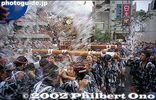
For some reason, it's fun to see people get wet...
|
|
|

Getting wet upside down might be an extra thrill...
|
|

Nainoa Thompson gave a touching speech about Japan-Hawaii friendship, their rediscovery of Japan ("Japan is not just Tokyo"), and Hokule'a's mission.
|
|
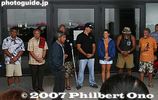
Nainoa introduces the rest of the crew and future Hokule'a captains being groomed to take over.
|
|

In front of the water truck. Soon to be filled with people and a portable shrine.
|
|
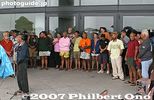
Hokule'a crew on stage.
|
|
|
|
|
|
|
|

Hokule'a at Yokohama
|
|

Wet women
|
|

Hokule'a and Kama Hele in Yokohama, June 10, 2007
|
|

Large crowd watch the mikoshi parade near Tomioka Hachimangu Shrine on Eitai-dori road.
|
|
|
|

Pukari Sanbashi Pier. Hokule'a can be seen on the left. On the right is another pier for sightseeing boats. The building in the middle is a resthouse.
|
|
|

As the portable shrines reach the shrine, they give one last show before returning to their parish.
|
|

The portable shrine gets a final mid-air toss while passing by Tomioka Hachimangu Shrine. This mid-air toss of the portable shrine is called "mai-age" or tossing up.
|
|

One after another, the mikoshi arrives in front of the shrine.
|
|

And give their last show.
|
|
|
|

Kyoto University 京都大学
|
|

Being at the shrine's torii entrance is a great place to watch the mikoshi.
|
|
|
|
|
|
|
|
|
| 2335 files on 10 page(s) |
1 |
 |
 |
 |
 |
|